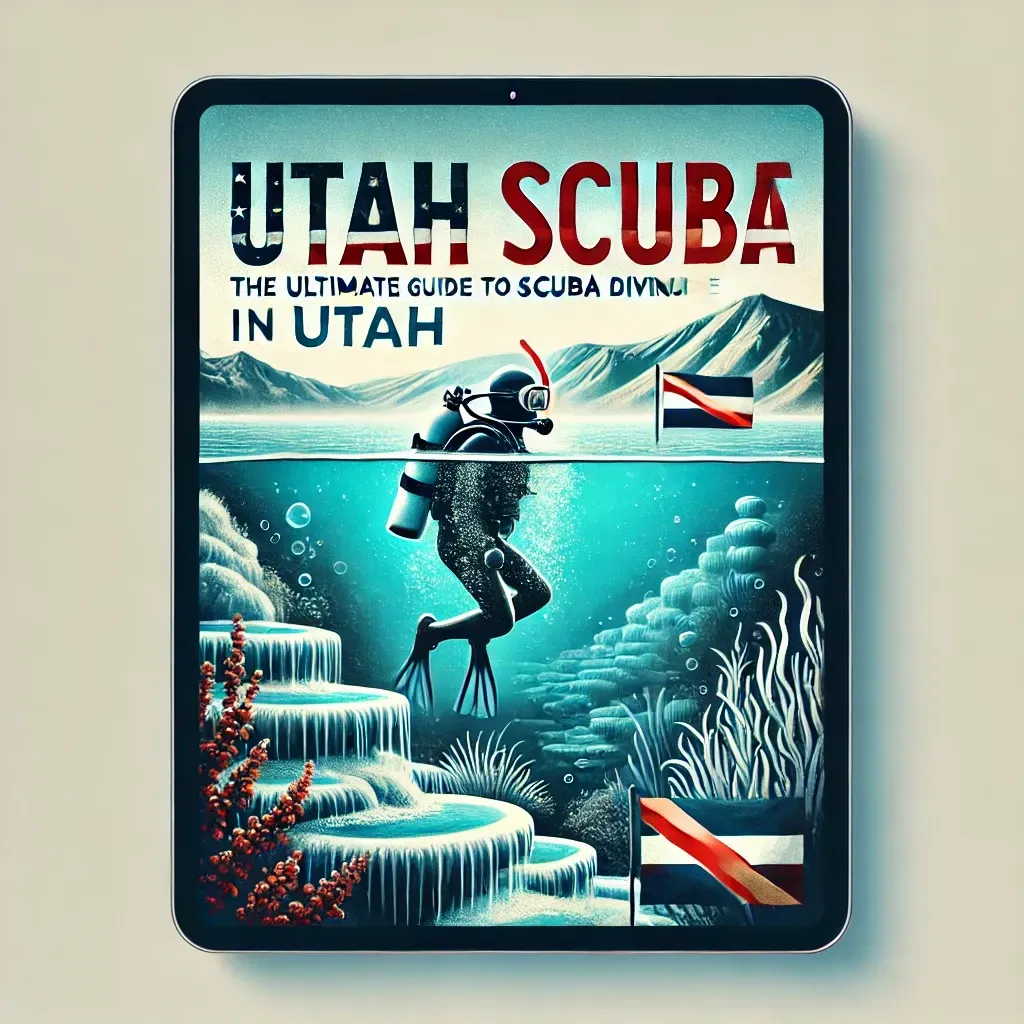
Utah Scuba Guide
"Please note that this post contains affiliate links, and I may earn a small commission if you make a purchase."
The Ultimate Guide to Scuba Diving in Utah
Utah may be known for its stunning desert landscapes and national parks, but it also offers some incredible freshwater diving opportunities. With crystal-clear mountain lakes, geothermal springs, and artificial reservoirs, Utah has unique dive sites for all experience levels. This guide explores the top five dive sites in Utah, detailing their unique features, available facilities, and essential information to help you plan your next dive adventure.
1. Homestead Crater
Location: Midway, UT
Best For: All levels; ideal for warm-water diving
Depth: Up to 65 feet
Water Temperature: 90°F to 96°F year-round
Overview
Homestead Crater is one of the most unique dive sites in the United States. This geothermal hot spring is located inside a natural limestone dome, making it an ideal year-round diving destination.
Unique Features
Warm, Crystal-Clear Water: The constant warm temperature makes it perfect for training and relaxation dives.
Underwater Platforms: Designed for scuba certification courses.
Cave-Like Structure: The enclosed dome provides an otherworldly diving experience.
Facilities
On-Site Dive Shop: Offers rentals, air fills, and training courses.
Amenities: Restrooms, changing rooms, and lodging available at Homestead Resort.
Cost
Entry Fee: Dive fees start at $22 per diver. Additional rental fees apply.
For more details, visit the Homestead Crater website.
2. Sand Hollow Reservoir
Location: Hurricane, UT
Best For: Beginner to advanced divers
Depth: Up to 40 feet
Water Temperature: 50°F to 80°F seasonally
Overview
Sand Hollow Reservoir is a favorite diving destination in southern Utah, featuring sunken wrecks and excellent visibility in its warm, red rock surroundings.
Unique Features
Sunken Wrecks: Includes a Cessna 210 airplane, a houseboat, and a VW Beetle.
Artificial Reefs: Designed to attract fish and improve underwater exploration.
Clear, Warm Waters: Great for underwater photography and training dives.
Facilities
Nearby Dive Shops: Offer rentals, guided dives, and training courses.
Amenities: Restrooms, picnic areas, and camping options available in the state park.
Cost
Entry Fee: State park entrance fees apply.
For more details, visit the Utah State Parks website.
3. Bonneville Seabase
Location: Grantsville, UT
Best For: Beginner to intermediate divers
Depth: 15 to 25 feet
Water Temperature: 68°F to 82°F
Overview
Bonneville Seabase is a man-made inland ocean where divers can swim with saltwater marine life, making it one of Utah’s most unusual dive sites.
Unique Features
Tropical Fish: Home to angel fish, puffers, and even small sharks.
Artificial Structures: Includes sunken platforms for training and exploration.
Saltwater Experience: A rare inland dive site with ocean-like conditions.
Facilities
On-Site Dive Center: Offers gear rentals and air fills.
Amenities: Picnic areas, showers, and campgrounds available.
Cost
Entry Fee: $25 per diver; gear rental additional.
For more details, visit the Bonneville Seabase website.
4. Blue Lake
Location: Wendover, UT
Best For: Beginner to advanced divers
Depth: Up to 60 feet
Water Temperature: 72°F year-round
Overview
Blue Lake is a natural warm spring-fed lake in Utah’s western desert, popular for its stable temperatures and good visibility.
Unique Features
Geothermal Spring: Provides warm water diving year-round.
Underwater Structures: Includes platforms for dive training.
Wildlife Encounters: Home to native fish, turtles, and occasional migratory birds.
Facilities
No On-Site Dive Shop: Bring your own gear and air fills.
Amenities: Nearby camping and basic rest areas available.
Cost
Entry Fee: Free public access.
For more details, visit the Utah Geological Survey.
5. Flaming Gorge Reservoir
Location: Northeastern Utah
Best For: Advanced divers
Depth: Over 400 feet in some areas
Water Temperature: 45°F to 65°F seasonally
Overview
Flaming Gorge is one of Utah’s deepest dive locations, offering breathtaking underwater rock formations and cold-water diving challenges.
Unique Features
Deep Water Diving: Some of the deepest in Utah.
Underwater Cliffs & Canyons: Incredible geology makes for stunning dives.
Cold-Water Species: Encounter trout, kokanee salmon, and even burbot.
Facilities
Nearby Dive Shops: Available in Dutch John and surrounding areas.
Amenities: Campgrounds, boat launches, and picnic areas available.
Cost
Entry Fee: National recreation area fees may apply.
For more details, visit the Flaming Gorge NRA website.
Frequently Asked Questions (FAQs)
Q: What is the best time of year to scuba dive in Utah?
A: Spring and summer offer the warmest water temperatures, but geothermal sites like Homestead Crater and Blue Lake allow for year-round diving.
Q: Do I need a dry suit for diving in Utah?
A: While not required for most locations, a 7mm wetsuit or dry suit is recommended for cold-water dives like Flaming Gorge.
Q: Can I rent scuba gear at Utah dive sites?
A: Some locations like Homestead Crater and Bonneville Seabase offer rentals, but others require bringing your own equipment.
Q: Are there any saltwater diving experiences in Utah?
A: Yes! Bonneville Seabase is a unique inland saltwater dive site with tropical fish.
Plan Your Utah Dive Adventure
From warm geothermal springs to deep canyon reservoirs, Utah offers an unforgettable diving experience. Whether you’re looking to dive with tropical fish at Bonneville Seabase, explore a sunken airplane in Sand Hollow, or enjoy the natural hot waters of Homestead Crater, there’s something for every diver in Utah.
Are you planning your next dive trip in Utah? Share your experiences in the comments and tag us on social media! 🌊🤿 #UtahScuba #DiveUtah
